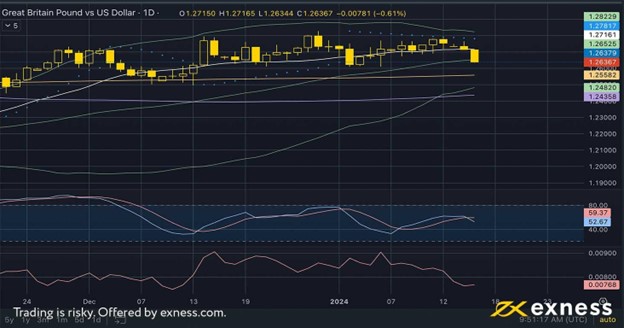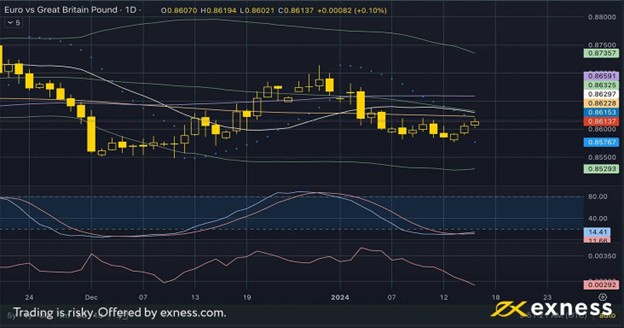After a reasonably slow start to the week as the USA celebrated Martin Luther King Day, activity picked up early on Tuesday as traders continued to update their expectations for the fund’s rate this year and looked ahead to key data from China, the UK and Canada in the next few days. This preview of weekly data looks at GBPUSD and EURGBP ahead of British inflation and the eurozone’s final inflation for December.
Weekly data: focus on inflation

There was no significant activity among major central banks last week, but expectations of a single cut by the Federal Reserve (‘the Fed’) at the end of this quarter remain high. According to CME FedWatch Tool, around 55% of participants expect five cuts to the funds rate between 20 March and 18 September, which would take it to 4-4.25%. There is currently no majority expectation for a cut by the European Central Bank until the summer, while a single cut by the Bank of England seems to be priced in for June.
This week’s main regular data are inflation from the eurozone, Canada and the UK, but traders are also looking at Chinese data – primarily GDP – on Wednesday morning. This isn’t a big week of data from the USA, so there might be more attention paid to currencies affected by the news.
Overall, banks’ earnings last week were quite positive, so sentiment on shares has improved somewhat. The next major earnings are expected next week, with Microsoft, Intel, Netflix and Tesla among others announcing results.
Cable, daily
The British job report released on 16 January December showed significant weakness, causing a decline in the pound across various currency pairs. The Claimant Count Change stood at 11,700, well above the expected figure of approximately 3,000. Additionally, November’s Total Average Earnings, at 6.5%, fell below expectations. Despite this, it represents a substantial annual change, indicating the continued presence of inflation in the UK in the foreseeable future. While inflation in the UK has decreased since the second quarter of the previous year, it remains higher than that in the USA.
In the realm of technical analysis, one would typically anticipate a breakout from a range to align with the direction of the preceding trend when there is no distinct pattern or shape evident on the chart. In this scenario, such an outcome remains plausible as the price has largely maintained its proximity to the upper bounds of the range, showing no indications of buying saturation. Nevertheless, the significance of Wednesday’s British inflation release cannot be overstated, as it has the potential to introduce a fresh catalyst and potentially disrupt the current technical outlook.
Don’t miss out the latest news, subscribe to LeapRate’s newsletter
In such a scenario, a prospective buyer might typically consider placing a pending order in the vicinity of the 200 SMA, situated around $1.255, while setting a target slightly above the most recent high. Anticipating the price’s ascent beyond $1.29 in the coming weeks seems challenging unless forthcoming data significantly deviate from expectations. The potential benefit of employing a pending order as inflation data approaches lies in the ability to swiftly remove the buy limit should the inflation figure unexpectedly fall below projections. This proactive approach prevents the trader from getting stuck in a potentially protracted losing position.
Key data this week
Bold indicates the most important releases for this symbol.
Wednesday 17 January
- 7.00 GMT: British annual headline inflation (December) – consensus 3.8%, previous 3.9%
- 7.00 GMT: British annual core inflation (December) – consensus 4.9%, previous 5.1%
- 7.00 GMT: British monthly headline inflation (December) – consensus 0.2%, previous negative 0.2%
- 7.00 GMT: British monthly core inflation (December) – consensus 0.4%, previous negative 0.3%
- 13.30 GMT: American retail sales (December) – consensus 0.4%, previous negative 0.3%
Thursday 18 January
- 13.30 GMT: initial jobless claims (13 January) – consensus 207,000, previous 202,000
Friday 19 January
- 7.00 GMT: British retail sales (December) – consensus negative 0.5%, previous 1.3%
- 15.00 GMT: Michigan consumer sentiment (preliminary, January) – consensus 70, previous 69.7
Euro-pound, daily
The euro’s gain against the pound has been stronger so far this week compared to the US dollar. One of the main factors in focus is that it’s not clear when or even whether the ECB will start to cut rates this year, while the BoE and the Fed are nearly certain and very likely to cut at least once each before the end of the second quarter. However, expectations for inflation dropped close to a low of two years in the eurozone, while the annual GDP in Germany for the full year of 2023 was slightly negative at 0.3%.
Don’t miss out the latest news, subscribe to LeapRate’s newsletter
On both the daily and the very long-term weekly chart, the overall trend for the euro-pound is sideways, so it’d be unlikely to see a move clearly below 85p or above 88p without a clear new driver, probably from monetary policy. In the short to medium term, the price is probably more likely to increase due to selling saturation and lower downward momentum, plus the short-term reaction to the British job report.
However, the big caveat is that both the UK and the eurozone release inflation on Wednesday, so volatility is likely to be significantly higher and the initial reaction might be false or ambiguous.
Key data this week
Bold indicates the most important releases for this symbol.
Wednesday 17 January
- 7.00 GMT: British annual headline inflation (December) – consensus 3.8%, previous 3.9%
- 7.00 GMT: British annual core inflation (December) – consensus 4.9%, previous 5.1%
- 7.00 GMT: British monthly headline inflation (December) – consensus 0.2%, previous negative 0.2%
- 7.00 GMT: British monthly core inflation (December) – consensus 0.4%, previous negative 0.3%
- 10.00 GMT: eurozone-wide annual headline inflation (final, December) – consensus 2.9%, previous 2.4%
- 10.00 GMT: eurozone-wide annual core inflation (final, December) – consensus 3.4%, previous 3.6%
Friday 19 January
- 7.00 GMT: British retail sales (December) – consensus negative 0.5%, previous 1.3%
DISCLAIMER:
The opinions in this article are personal to the writer and do not reflect those of Exness or Leap Rate.

